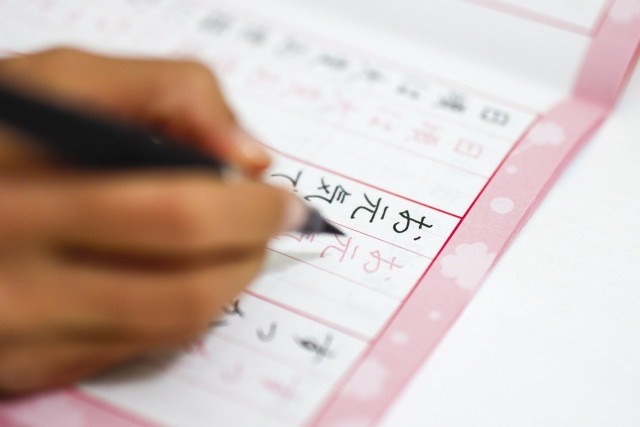There’s many different Japanese language proficiency tests offered in addition to the official Japanese Language Proficiency Test (JLPT). Here’s an extensive list of Japanese language tests you can take to test your mastery of the language, as well as spruce up your application or resume!
Table of Contents
- JLPT
- Alternative Japanese Proficiency Tests to the JLPT
- Business Japanese
- Specific Skill Tests
- Other Tests Worth a Mention
JLPT

The Japanese Language Proficiency Test - 日本語能力試験 (Nihongo nouryoku shiken) - known as JLPT for short, is arguably the most famous way to test your Japanese level in the world.
When people talk about their Japanese level, they most often refer to the JLPT levels, which are named N5 (lowest) to N1 (highest). Higher level education and jobs will refer to this measure to see if you are suitable for the program or job.
Offered: 2 times a year (July, December)
Cost: 6,500 yen
Overseas Testing: Yes
Read all about it here: https://we-xpats.com/en/guide/as/jp/detail/9065/
Why Are JLPT Alternatives Necessary?
But there are so many other Japanese proficiency tests - why are the alternatives necessary?
There are mainly 3 reasons:
-
The JLPT is only offered 2 times a year - in July and December. That means if you absolutely need to take and pass (!!) the JLPT by a certain time, your plans could be thrown off by half a year or more if you happen to fail the exam. (Or if the test itself is canceled, as it was in 2020 and 2021 during the pandemic)
-
The JLPT only tests vocabulary, grammar, reading comprehension and listening. In order to check your speaking and/or writing ability or other specific skills in the Japanese language not covered on the JLPT, other tests are necessary.
-
Some schools or companies will list that they accept a Japanese language level equivalent to a certain JLPT level. If so, then as long as you take a test that has a clear correlation to the JLPT and its levels, you can prove your Japanese level without taking the official JLPT if you cannot in time for whatever reason.
Writer's Pick
Alternative Japanese Proficiency Tests to the JLPT

So because of the reasons listed above, it’s important to know that there are other accepted alternatives to the JLPT.
Note: While these are considered great alternatives, some even explicitly declaring that their test is accepted by both immigration services in Japan and other organizations, unfortunately not every school or company will recognize them. Thus, looking at the details in regards to the job or program you want to get into is important.
J.Test ・実用日本語検定
The Practical Japanese Language Test or J.Test is also a test of Japanese proficiency, known as 「実用日本語検定 Jitsuyou Nihongo Kentei」 in Japanese. Unlike JLPT, this examination offers only three types of tests, and has sections where you actually write in the answers in Japanese such as for how to read the kanji. You can also test your abilities above N1, and is much more focused on practical Japanese that one would you use on a daily basis.
They offer certifications for beginner, intermediate, and advanced levels. Your score on the test determines what level you are within the test. This is how it correlates to the JLPT.
|
J.Test (3 types of tests) |
JLPT Level |
|
1. A~C Level Test (max 1000 points) |
|
|
2. D~E Level Test (max 700 points) |
|
|
3. F~G Level Test (max 350 points) |
|
You can see from this chart that if you score higher than Pre-B level, it’s above N1 level. In fact, if you get 900 points (out of a max 1000) and up, you’re considered near native. It’s a great way to challenge yourself beyond the JLPT
Offered: 6 times a year (F~G Level is only offered twice a year)
Cost: 5,200 yen
Overseas Testing: Yes. Check if you can take it in your region.
※ J.TEST Japan Secretariat / Nihongo Kentei Kyokai, "J.TEST Practical Japanese Test" “CEFR and J-TEST”
NAT-TEST
The NAT-TEST (NAT stands for Nihongo Achievement Test) is considered an equivalent to the JLPT in terms of format, as there are 5 levels that you can take which correlate directly to the JLPT levels.
It even claims to be “the best way to prepare for the JLPT” on its English homepage.
Offered: 6 times a year
Cost: 5,500 yen
Overseas Testing: Yes. Check the homepage if you can take it in your country.
※NAT-TEST
JPT ・日本語能力試験
Not to be confused with the JLPT, which has the exact same name in Japanese, the JPT or the Japanese Proficiency Test, is another alternative to the JLPT.
The website states that it is “recognized by Ministry of Justice Immigration Services Agency of Japan” to “enter Japanese language education institutions” as long as you score a minimum of 315 points (N5 level).
※JPT, “Differences between the JLPT”
However, the format is different as tests are not separated by level, there being only 1 test for all levels. The number of points you earn on the test determines your level.
|
JPT Score |
JLPT Level |
|
660 points & up |
N1 |
|
525 points & up |
N2 |
|
430 points & up |
N3 |
|
375 points & up |
N4 |
|
315 points & up |
N5 |
Offered: 6 times a year
Cost: 5,500 yen
Overseas Testing: Yes. Check the homepage if you can take it in your country.
※JPT
J-CAT
J-CAT, which stands for Japanese Computerized Adaptive Test is one of the rare online options on this list.
Note: As of April 1, 2020, you cannot register to take the test on an individual basis. It must be registered for as part of a group belonging to an academic institution.
You can take 1 of 3 tests: the J-Cat Challenge, Performance or Certificate.
The J-CAT Challenge and Performance are both online tests. The main difference is whether you can download a PDF of your score afterwards.
The J-CAT Certificate is an in-person test held by the accredited host institution.
Like the JPT, it’s one test, and your level is determined by your score. The test is much shorter than the others, however, at around 45 ~ 90 minutes.
|
J-CAT Score |
JLPT Level |
|
300 points & up |
N1 |
|
250 points & up |
N2 |
|
200 points & up |
N3 |
|
150 points & up |
N4 |
※J-CAT, “J-CAT のスコアについて”
|
Test Name |
Where to Take Test |
Cost |
|
J-CAT Challenge |
Online |
1000 yen |
|
J-CAT Performance |
Online |
2000 yen |
|
J-CAT Certificate |
In person |
4000 yen |
※J-CAT, “サービスプラン”
We will update once the J-CAT is available to individual test takers again.
※J-CAT
TOPJ
TOPJ, or the「実用日本語運用能力試験 Jitsuyou Nihongo Unei Nouryoku Shiken」in Japanese, is a little less known as the testing overseas is limited to select Asian countries. Apart from knowledge of Japanese language, it also tests your understanding of Japanese culture and customs.
There’s 3 tests - beginner, intermediate and advanced - and based on your score, your level will be determined between A, B and C within the test.
Here’s how the TOPJ levels correlate with the JLPT.
|
TOPJ (3 types of tests) |
JLPT Level |
|
1. Advanced |
|
|
2. Intermediate |
|
|
3. Beginner A-4 Level (80% & up on all sections) |
|
Offered: 6 times a year
Cost: 5,000 yen in Japan
Overseas Testing: Yes. Check which countries (limited to Asia) have tests.
※TOPJ
BJT (Business Japanese Proficiency Test)
The BJT or Business Japanese Proficiency Test is often mentioned as a good alternative to higher level JLPT scores. Many companies ask that you have business level Japanese skills, and the BJT is a great way to prove that.
It’s also more practical, so you would be using what you learn for the test in your actual work life as well. However, you do have to be N2 or N1 level in Japanese ability in order to do well on the test.
Check the next section about business Japanese tests for more information.
Business Japanese Tests

BJT (Business Japanese Proficiency Test)
The BJT or Business Japanese Proficiency Test is a proficiency test determining the applicant's ability to interact using the Japanese language in a business setting.
The test is done on the computer at testing sites. The test itself has 3 parts - listening, listening and reading comprehension, and reading comprehension.
The BJT measures the examination result through one test, scored from 0 to 800 points. The higher the score, the higher your level out of 6, called J5 (lowest) to J1+ (the highest).
The test recommends being N2 or N1 level of the JLPT to get a higher score on the BJT as this tests if you are able to use an advanced level of Japanese in practical business settings. While there’s no exact score correlation, most N1 level test takers got J2 or J1 on the BJT. However, if you score over 600 points (out of 800), you are considered J1+ level and “able to sufficiently communicate in Japanese in any business situation”.
※BJT, “Grade and Evaluation”
Offered: Almost all year; reserve a time and date online
Cost: 7,000 yen in Japan
Overseas Testing: Yes. Please check Q6 in “Test Methods” to see if your country is listed
※BJT
STBJ (Standard Test for Business Japanese)
This test , known as「標準ビジネス日本語テスト Hyoujun Business Nihongo Test」 in Japanese, is not as known as the BJT because the places you can take the test are quite limited.
Currently it is offered 6 times a year in China, Vietnam and Sri Lanka. It is held in a few other countries, including in Japan, but rather than in public venues for individuals, it’s usually arranged by Japanese language schools for its students.
The results are used to prove Japanese language ability when finding a job in Japan. applying for a job at a Japanese company in the above countries, and also for applying to study at a Japanese university or language school.
The cost and details differ per country, and you can find more information here.
※STBJ
Specific Skill Tests
Most of the tests mentioned above simply test your ability to read and listen, but how about writing and kanji? Take a look!
Kanji

If you want to simply test your kanji knowledge, taking the 漢検 (Kanken) short for 「漢字能力検定 Kanji Nouryoku Kentei」 is recommended!
There's no direct correlation with the JLPT, but it’s still a great thing to put on your resume. Students from elementary school to high school, university students and even adults take this test!
Kanken has 12 levels total, from level 10 (lowest) to level 1 (highest). Of course you have to be able to read AND write the kanji. In the higher levels, you are expected to know idioms as well as recognize kanji from classic literature.
It’s held 3 times a year, but there is also a version you can take online (up to level 2) any time as well.
※Kanken
Japanese Speaking Tests

As none of the tests above test your ability to speak Japanese, the following do! (There may be more offered in one's own country, so make sure to look it up!)
JSST (Japanese Standard Speaking Test)
The Japanese Standard Speaking Test (JSST) tests your speaking ability by asking you 10 questions. Your answers will be recorded and then judged for your final score. It will only take about 15 minutes to take the actual test.
There are 10 score levels total, with 1 being the lowest and 10 being the most advanced. The questions are completely randomized, so you can’t memorize answers for the test. They will test you not just on how accurate your Japanese is, but how much information you can naturally convey while following directions.
Cost: 6,050 yen with a score and comment sheet, 4,950 yen with just the score sheet without comments
Overseas Testing: Yes
※JSST
日本語会話検定 (JapaTalk)
The Japanese Conversation Test is offered for paying members of JapaTalk, a service that offers Japanese speaking lessons over Skype. They will grade your communication, intonation, keigo and other speaking skills in a 25 minute Skype conversation.
Cost (for members of JapaTalk only): 3300 yen for levels 3 & 4, 4400 yen for levels 2 and up.
※JapaTalk, "Japanese Conversation Test"
OPI (Oral Proficiency Interview) Test
This is a 30 minute phone interview test, available for many different languages, held by The American Council on the Teaching of Foreign Languages. There’s 4 proficiency levels from Novice to Superior, and tests not only accuracy but the content of your speech and ability to use the language to discuss various topics.
Unfortunately, one can’t take the test in Japan, but it’s possible to take the test online. It costs 120 USD to take the test and get a certificate.
※LTI, “ACTFL Speaking Assessment: The Oral Proficiency Interview® (OPI)” ※日本語OPI研究会, “OPIとは?”
Other Tests Worth a Mention

EJU
Although not a Japanese proficiency test itself, the EJU or “Examination for Japanese University Admission for International Students” includes a Japanese section. If you are a student hoping to study in Japan, there’s a large chance you will have to take this test to be admitted into a university.
The Japanese test section will provide a Japanese proficiency level, so you most likely won’t need to take the JLPT in addition to the EJU.
※EJU
日本語検定 Nihongo Kentei
This is a Japanese proficiency test geared toward native Japanese people, although anyone can take it. It focuses on Japanese usage in everyday life, making sure that people are using Japanese correctly. Not many foreign nationals take this test, as the other tests above are sufficient to prove Japanese proficiency. But this might be a fun challenge.
※日本語検定
To Conclude
We hope this list helps you out to choose the best Japanese language test for you! We’ll update this article if we find more!




























